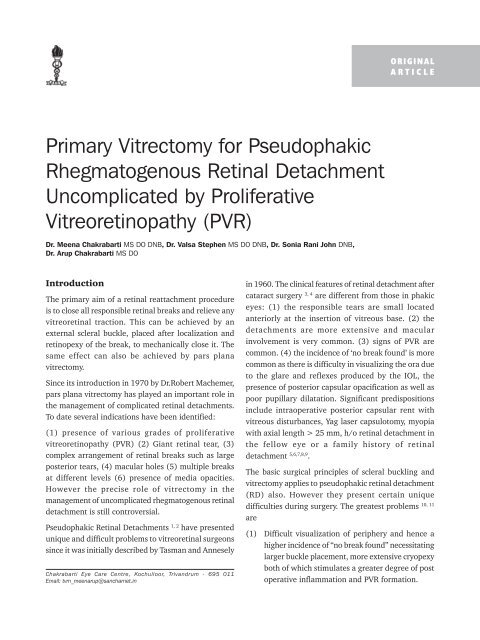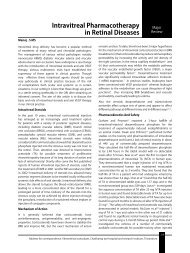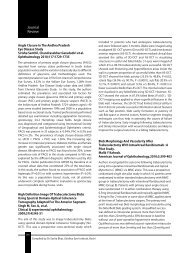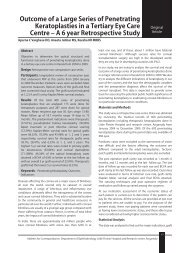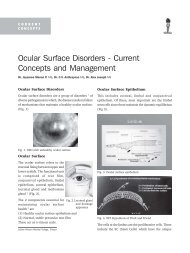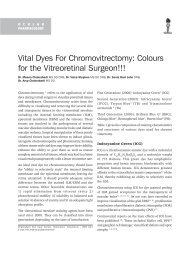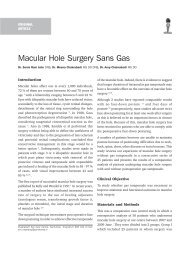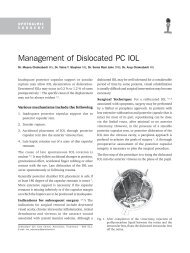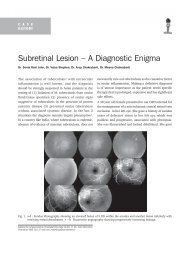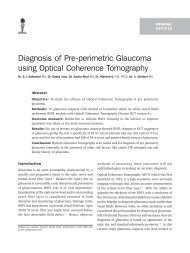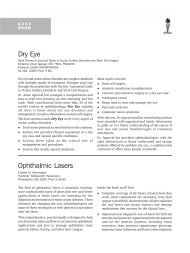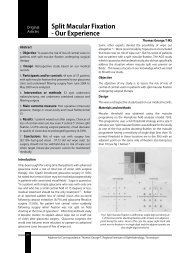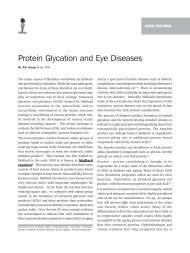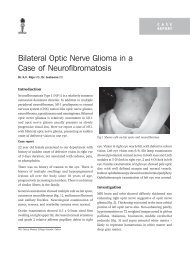Primary Vitrectomy for Pseudophakic Rhegmatogenous ... - KSOS
Primary Vitrectomy for Pseudophakic Rhegmatogenous ... - KSOS
Primary Vitrectomy for Pseudophakic Rhegmatogenous ... - KSOS
Create successful ePaper yourself
Turn your PDF publications into a flip-book with our unique Google optimized e-Paper software.
June 2008 K.V. Raju et al. - Fungal Corneal Ulcer 151<br />
<strong>Primary</strong> <strong>Vitrectomy</strong> <strong>for</strong> <strong>Pseudophakic</strong><br />
<strong>Rhegmatogenous</strong> Retinal Detachment<br />
Uncomplicated by Proliferative<br />
Vitreoretinopathy (PVR)<br />
Dr. Meena Chakrabarti MS DO DNB, Dr. Valsa Stephen MS DO DNB, Dr. Sonia Rani John DNB,<br />
Dr. Arup Chakrabarti MS DO<br />
Introduction<br />
The primary aim of a retinal reattachment procedure<br />
is to close all responsible retinal breaks and relieve any<br />
vitreoretinal traction. This can be achieved by an<br />
external scleral buckle, placed after localization and<br />
retinopexy of the break, to mechanically close it. The<br />
same effect can also be achieved by pars plana<br />
vitrectomy.<br />
Since its introduction in 1970 by Dr.Robert Machemer,<br />
pars plana vitrectomy has played an important role in<br />
the management of complicated retinal detachments.<br />
To date several indications have been identified:<br />
(1) presence of various grades of proliferative<br />
vitreoretinopathy (PVR) (2) Giant retinal tear, (3)<br />
complex arrangement of retinal breaks such as large<br />
posterior tears, (4) macular holes (5) multiple breaks<br />
at different levels (6) presence of media opacities.<br />
However the precise role of vitrectomy in the<br />
management of uncomplicated rhegmatogenous retinal<br />
detachment is still controversial.<br />
<strong>Pseudophakic</strong> Retinal Detachments 1, 2 have presented<br />
unique and difficult problems to vitreoretinal surgeons<br />
since it was initially described by Tasman and Annesely<br />
Chakrabarti Eye Care Centre, Kochulloor, Trivandrum - 695 011<br />
Email: tvm_meenarup@sancharnet.in<br />
ORIGINAL<br />
ARTICLE<br />
in 1960. The clinical features of retinal detachment after<br />
cataract surgery 3, 4 are different from those in phakic<br />
eyes: (1) the responsible tears are small located<br />
anteriorly at the insertion of vitreous base. (2) the<br />
detachments are more extensive and macular<br />
involvement is very common. (3) signs of PVR are<br />
common. (4) the incidence of ‘no break found’ is more<br />
common as there is difficulty in visualizing the ora due<br />
to the glare and reflexes produced by the IOL, the<br />
presence of posterior capsular opacification as well as<br />
poor pupillary dilatation. Significant predispositions<br />
include intraoperative posterior capsular rent with<br />
vitreous disturbances, Yag laser capsulotomy, myopia<br />
with axial length > 25 mm, h/o retinal detachment in<br />
the fellow eye or a family history of retinal<br />
detachment 5,6,7,8,9 .<br />
The basic surgical principles of scleral buckling and<br />
vitrectomy applies to pseudophakic retinal detachment<br />
(RD) also. However they present certain unique<br />
10, 11<br />
difficulties during surgery. The greatest problems<br />
are<br />
(1) Difficult visualization of periphery and hence a<br />
higher incidence of “no break found” necessitating<br />
larger buckle placement, more extensive cryopexy<br />
both of which stimulates a greater degree of post<br />
operative inflammation and PVR <strong>for</strong>mation.
152 Kerala Journal of Ophthalmology Vol. XX, No. 2<br />
(2) The location of the IOL presents problem during<br />
scleral buckling and vitrectomy. Anterior<br />
movement of the anterior chamber intraocular<br />
lens (caused by hypotony) during subretinal fluid<br />
drainage or during fluid - air exchange can<br />
damage the cornea or press against the angle<br />
causing hyphema intraoperatively.<br />
Presence of PC rent causes problems <strong>for</strong> visualization<br />
after fluid air exchange due to moisture condensation<br />
on the IOL intraoperatively. So also silicone IOL-silicone<br />
oil interaction leaves behind a firmly adherent layer of<br />
silicone oil, impairing intraoperative visualization as<br />
well as the postoperative visual recovery.<br />
Previous reports on the management of retinal<br />
detachment has shown a poor rate of anatomic success<br />
in the presence of trans-sclerally sutured posterior<br />
chamber intraocular lens and have speculated the<br />
existence of certain risk factors which were associated<br />
with poor prognosis <strong>for</strong> surgical repair. These includes<br />
presence of vitreous in front of the intraocular lens,<br />
poor pupillary dilatation, difficulty in visualization<br />
during fluid- air exchange due to air gushing into<br />
anterior chamber and persistent tractional <strong>for</strong>ces at the<br />
vitreous base due to the haptic of the IOL or the fixation<br />
sutures.<br />
In this paper we analyze the results of primary<br />
vitrectomy in 50 eyes with uncomplicated pseudophakic<br />
rhegmatogenous retinal detachment.<br />
Materials and Methods<br />
We per<strong>for</strong>med a prospective study on the efficacy of<br />
primary pars plana vitrectomy in the management of<br />
uncomplicated pseudophakic rhegmatogenous retinal<br />
detachment in 50 consecutive patients attending our<br />
tertiary care referral centre between 2004 and 2007.<br />
The patient’s age ranged from 7 yrs – 64 yrs, the M: F<br />
ratio was 2:1. All patients had a retinal detachment<br />
less than a month old and the macula was off in all the<br />
cases. There was no evidence of PVR. All patients were<br />
pseuodophakic and included 36 eyes with posterior<br />
chamber intraocular lens implants, 11 eyes with<br />
anterior chamber intraocular lens and 3 eyes with<br />
transclerally sutured posterior chamber intraocular lens<br />
implants.<br />
The surgical procedure included a conventional pars<br />
plana vitrectomy. Any vitreous traction present around<br />
the retinal tear was relieved. Indirect ophthalmoscopy<br />
was then per<strong>for</strong>med to rule out any other preexisting<br />
or iatrogenic retinal tears. Fluid-air exchange with<br />
simultaneous endodrainage was per<strong>for</strong>med either<br />
through the retinal tear if it was posterior or through a<br />
drainage retinotomy. Once pneumohydraulic<br />
reattachment was achieved, retinopexy was per<strong>for</strong>med<br />
either by trans- scleral cryopexy or LIO laser barrage.<br />
Long acting tamponade was achieved by a non<br />
expansile mixture of air and C 3 F 8 gas. The patients<br />
were advised to maintain a face down position <strong>for</strong><br />
atleast 12 hours – 16 hours daily <strong>for</strong> 3 weeks<br />
postoperatively. The duration of hospital stay was 3<br />
days. The patients were monitored <strong>for</strong> any<br />
postoperative reaction and rise of intraocular pressure.<br />
Follow up examination was per<strong>for</strong>med every month <strong>for</strong><br />
the first 3 months and then at 2 monthly intervals <strong>for</strong><br />
the next 6 months. The duration of follow up varied<br />
from 6 months- 48 months.<br />
Results<br />
The patients were of the age group ranging from 7 years<br />
to 54 years (Mean- 37 years). The male:female ratio<br />
was 2:1. All patients had a detachment of less than a<br />
month due to superior breaks and the macula was off<br />
in all cases. The preoperative fundus findings were<br />
tabulated in Table 1.<br />
Table 1: Preoperative Fundus Findings & Relevant Clinical<br />
Features<br />
1. Pseudophakia : (PCIOL: 36, AC IOL: 11,<br />
SF IOL:3)<br />
2. Hypotony : 15 eyes (30 %)<br />
3. AS reaction (Flare and Cells) : 10 eyes (20 %)<br />
4. Poor pupillary dilatation : 12 eyes (24 %)<br />
5. IOL Malposition : 4 eyes (8 %)<br />
6. PCO : 9 eyes (18 %)<br />
7. PC Rent : 6 eyes (12 %)<br />
8. Vitreous in AC : 3 eyes (6 %)<br />
9. Macula off : 50 eyes (100 %)<br />
10. No break found : 9 eyes (18 %)<br />
11. Choroidal detachment : 9 eyes (18%)<br />
12. Vitreous haze : 5 eyes (10 %)<br />
13. Total RD : 14 eyes (28 %)<br />
14. PVR C Grade : 5 eyes (10 %)<br />
15. Vitreous haemorrhage : 3 eyes (6 %)
June 2008 M. Chakrabarti et al. - PPV in <strong>Pseudophakic</strong> RD 153<br />
The study population included 36 eyes with PC IOL<br />
implants (72 %); 11 eyes with AC IOL implants<br />
(22 %); and 3 eyes with trans-sclerally sutured PC IOL<br />
(6 %) implants. Preoperative hypotony (30 %);<br />
significant anterior chamber reaction (20 %); vitreous<br />
in anterior chamber (6 %); poor pupillary dilatation<br />
(24 %); malpositioned IOLs (8 %), PCO (18 %) and<br />
presence of vitreous haze (10 %) made intraoperative<br />
visualization difficult. Preoperative topical and systemic<br />
steroid administration to control the inflammation and<br />
combat hypotony was successful in achieving a quiet<br />
eye in 20 % cases. Use of flexible iris retractors,<br />
sphincterotomies, posterior capsulotomy and repositioning<br />
of the IOL into the bag or sulcus was per<strong>for</strong>med intra<br />
operatively to achieve adequate pupillary space <strong>for</strong><br />
visualization of fundus periphery and to per<strong>for</strong>m a<br />
thorough base excision. 18 % of patients had choroidal<br />
detachments associated with hypotony and total retinal<br />
detachment. Choroidal detachments were drained<br />
be<strong>for</strong>e placement of infusion canula. A break<br />
responsible <strong>for</strong> the detachments could not be identified<br />
in 18 % of patients either pre or intraoperatively.<br />
Table 2. Intraoperative problems and complications<br />
Sl. Introperative Incidence Management<br />
No Problems ( %)<br />
1 Corneal Odema 12 eyes<br />
(24 %)<br />
Debridement<br />
2. Intraoperative 2 eyes Viscoelastic inj<br />
hyphema (4%) into AC<br />
3. Pupillary Miosis 14 eyes Iris Retractors,<br />
(28 %) adding Adrenalin<br />
to infusion fluid<br />
4. Displacement 2 eyes Conservative (1);<br />
of IOL (4 %) Repositioning (1)<br />
5. Shallowing 4eyes Re<strong>for</strong>med<br />
of AC (8 %) spontaneously with<br />
prone positioning<br />
6. Blood in 1 eye Capsulotomy<br />
Capsular bag (2%) and drainage<br />
7. Air in AC during 3 eyes<br />
fluid air exchange. (6%)<br />
8. Moisture condensat- 6 eyes Cleared with flute<br />
ion on IOL (12%) needle<br />
9. Difficulty in base 4 eyes Scleral depression<br />
excision (8 %) assisted base<br />
excision<br />
Development of corneal odema intraoperatively and<br />
pupillary miosis were the two major intraoperative<br />
difficulties experienced during surgery. Epithelial<br />
debridement was necessary in 24 % of eyes to clear<br />
the visual axis <strong>for</strong> adequate visualization during<br />
surgery.Pupillary miosis intraoperatively was countered<br />
using iris retractors or by adding adrenalin to the<br />
infusion fluid in 28 % of cases. Intraoperative hyphema<br />
was caused by fluctuations in the intraocular pressure<br />
intraoperatively in 4 %. Injection of viscoelastic into<br />
the anterior chamber cleared the pupillary area.<br />
Shallowing of the anterior chamber after fluid- air<br />
exchange was observed in 8 % of eyes. In these 4<br />
patients, the chamber re<strong>for</strong>med spontaneously when<br />
prone position was maintained postoperatively. Minimal<br />
displacement of the PC IOL which occurred<br />
intraoperatively in one patient was managed<br />
conservatively. Collection of blood within the capsular<br />
bag intraoperatively impaired visualization in 2 % of<br />
eyes necessitating central capsulectomy <strong>for</strong> drainage.<br />
Bubbling of air into the anterior chamber during fluid<br />
air exchange occurred in all the 3 patients with sclerally<br />
sutured PC IOLs impairing visualization. Intraoperative<br />
moisture condensation in 12% was cleared by flute<br />
needle. Moisture condensation on the posterior surface<br />
of the IOL in 6 eyes (12 %) with pre-existing posterior<br />
capsular rent was managed by gently sweeping the<br />
posterior surface of the IOL with a soft tipped aspiration<br />
needle.<br />
The patients were followed up <strong>for</strong> 12 months. The<br />
anatomic reattachment rate was 96% with a single<br />
procedure. In 2 eyes (4 %) recurrent retinal detachment<br />
with advanced proliferative vitreoretinopathy and gross<br />
hypotony necessitated revitrectomy with silicone oil<br />
tamponade.80 % of the patients achieved a visual acuity<br />
> 6/12 to 6/60. Poor visual recovery in 10 eyes (20<br />
%) was attributed to (1) Epiretinal membrane<br />
<strong>for</strong>mation 2 eyes (4 %); (2) Macular hole 2 % (4)<br />
persistent cystoid macular odema 4 % (5) persistence<br />
of SRF in macular area detected by OCT in 10 %.<br />
We analyzed factors which predicted poor visual<br />
recovery and redetachment. These included<br />
preoperative anterior chamber reaction, choroidal<br />
detachment, older patients and longer duration of<br />
detachment. There was no significant difference in the<br />
reattachment rates with the different IOL types.
154 Kerala Journal of Ophthalmology Vol. XX, No. 2<br />
Discussion<br />
The basic surgical principles of scleral buckling and pars<br />
plana vitrectomy continues to apply to pseudophakic<br />
retinal detachment, but there are certain problems<br />
unique to pseudophakia. The greatest problem in<br />
repairing a pseudophakic retinal detachment is the<br />
difficulty in visualizing the peripheral retina. Retinal<br />
breaks cannot be found in as many as 20 % of patients<br />
due to small miotic pupils, difficulty in viewing through<br />
edge of IOL, perilenticular membranes and posterior<br />
capsular opacification.<br />
Visualization tends to be more difficult in iris fixated<br />
and AC IOLs. Because of uncertain visualization, there<br />
may be a tendency towards greater use of cryotherapy<br />
which is associated with increased inflammation and<br />
postoperative PVR. The location of the IOL, whether in<br />
anterior chamber, iris plane or in the posterior chamber<br />
presents problems during scleral buckling and<br />
vitrectomy.<br />
1. An anterior chamber lens, during scleral<br />
depression may be <strong>for</strong>ced against the angle<br />
causing bleeding.<br />
2. Mobility of iris fixated lenses can cause corneal<br />
damage from anterior displacement at time of<br />
subretinal fluid drainage when the eye is<br />
hypotonous.<br />
3. An intravitreal gas bubble will also displace an<br />
iris fixated lens anteriorly. Prior injection of air/<br />
healon into the anterior chamber will prevent this.<br />
4. Postoperative pupillary block and choroidal<br />
detachment also causes anterior displacement of<br />
IOL against cornea requiring immediate<br />
repositioning to prevent irreparable corneal<br />
damage.<br />
5. Dislocation of lens into vitreous can occur with<br />
posterior chamber intraocular lenses. Posterior<br />
chamber intraocular lenses pose the fewest<br />
difficulties during scleral buckling and vitreous<br />
surgery.<br />
6. Intraoperative moisture condensation on the<br />
posterior surface of IOL during fluid- air exchange<br />
may impair visualization of posterior segment in<br />
eyes with preexisting posterior capsular rents.<br />
7. Interaction between silicone oil and silicone<br />
foldable IOL in the presence of PC rent causes<br />
impaired visualization <strong>for</strong> surgery.<br />
8. In our series of 3 cases of pseudophakic retinal<br />
detachment associated with trans-sclerally sutured<br />
posterior IOLs, the clinical features and problems<br />
faced during surgery did not differ from eyes with<br />
conventional posterior chamber intraocular lenses.<br />
All patients had well dilated pupils. Absence of<br />
posterior capsular opacification and perilenticular<br />
cocoon membranes made visualization of retinal<br />
periphery easy. Intraoperative problems such as<br />
IOL dislocation, significant IOL decentration,<br />
vitreous haemorrahage, hyphema and<br />
pseudophakic corneal touch were not experienced<br />
while managing these patients. The only<br />
intraoperative problem was difficulty in<br />
visualization during fluid - air exchange as air<br />
gushed into the anterior chamber. Similar<br />
problems are experienced in eyes with anterior<br />
chamber IOLs or posterior chamber IOLs with<br />
posterior capsular rent or following YAG<br />
capsulotomy.<br />
IOL explantation <strong>for</strong> intraoperative decentration or<br />
dislocation of the IOL or to permit visualization <strong>for</strong><br />
vitrectomy was not necessary in any patient. Adequate<br />
anterior vitreous base dissection was possible in all the<br />
eyes which permitted intraoperative retinal flattening.<br />
An anatomic success rate of 93.0% (88.8-93%) <strong>for</strong><br />
pseudophakic retinal detachment cases have been<br />
reported by Schepens in 1991. The PC IOL group has a<br />
significantly greater prevalence of good postoperative<br />
visual acuity compared to AC IOL groups which have<br />
the worst visual prognosis. The cause of poor visual<br />
recovery after retinal detachment repair in patients with<br />
AC IOL is attributed to the increased occurrence of<br />
postoperative corneal oedema. Patients having an AC<br />
IOL implant have a higher degree of occurrence of break<br />
down of BAB (blood-aqueous barrier) be<strong>for</strong>e treatment<br />
of retinal detachment. There<strong>for</strong>e the persistent corneal<br />
dysfunction in the presence of an AC IOL may trigger<br />
the postoperative corneal oedema and explain the<br />
poorest visual acuity outcomes.<br />
The statistically significant poor prognostic indicators<br />
<strong>for</strong> reattachment are.
June 2008 M. Chakrabarti et al. - PPV in <strong>Pseudophakic</strong> RD 155<br />
1. Presence of AC IOL (2) Eyes with AC reaction (3)<br />
Presence of macula off RD (4) Preoperative PVR (5)<br />
Older age etc<br />
The reasons <strong>for</strong> failure include the development of<br />
proliferative vitreoretinopathy, failure to close an<br />
existing break or development of a new break. Although<br />
the anatomic reattachment rate is comparable to that<br />
in phakic eyes, the visual results are not so good. The<br />
postoperative visual recovery is worst with AC lenses<br />
due to the presence of corneal decompensation and<br />
higher incidence of cystoid macular odema. The other<br />
causes of poor visual recovery after successful anatomic<br />
reattachment are macular degeneration, cystoid<br />
macular edema, epimacular membrane proliferation,<br />
macular pucker and photoreceptor dysfunction.<br />
Pars plana vitrectomy has become accepted as the<br />
treatment of choice <strong>for</strong> certain complex retinal<br />
detachments. The commonest indications are difficult<br />
breaks and PVR. In simple retinal detachments, external<br />
scleral buckling procedures are still preferred. The role<br />
of primary vitrectomy in the management of these cases<br />
is still controversial.<br />
Scleral buckling procedures can be complicated by a<br />
variety of intraoperative and postoperative<br />
complications which can impair the final visual<br />
result 12 . A combination of factors may result in intrusion,<br />
extrusion or infection of the scleral buckle 13, 14 . Mobility<br />
problems may be induced by the presence of bulky<br />
scleral buckle or due to disinsertion or rupture of the<br />
extraocular muscle during surgery. External drainage<br />
of SRF may result in subretinal haemorrhage, retinal<br />
incarceration or a retinal break. Encircling elements<br />
may reduce the blood flow as shown by colour doppler<br />
studies and results in anterior segment ischaemia.<br />
Refractive changes are a rule after scleral buckling<br />
procedure and may be especially problematic if a<br />
significant degree of anisometropia has been induced<br />
in a previously emmetropic eye. Buckling elements may<br />
result in distortion of macula and reduction of macular<br />
function. Further buckling procedures may be<br />
associated with postoperative CME which may account<br />
<strong>for</strong> delayed return of vision.<br />
<strong>Vitrectomy</strong> 12, 13, 14 offers certain advantages over scleral<br />
buckling in that it af<strong>for</strong>ds a direct approach to vitreous<br />
traction. Internal drainage of SRF with simultaneous<br />
FAE allows pneumohydraulic retinal reattachment 15,<br />
16 . Vitreous opacities are removed at the time of<br />
vitrectomy and postoperative mobility is less. It should<br />
also be recognized that there are potentially hazardous<br />
complications of this procedure like progression of<br />
nuclear sclerotic cataract, glaucoma, iatrogenic tears<br />
and detachment and vitreous haemorrhage, etc 17, 18 .<br />
<strong>Primary</strong> pars plana vitrectomy offers an alternative to<br />
scleral buckling procedures in the management of<br />
selected cases of primary rhegmatogenous retinal<br />
detachment. A larger series with longer follow up is<br />
needed be<strong>for</strong>e the efficacy of this procedure is<br />
established.<br />
References<br />
1. Norman S Jaffe, MD Hentry M, Clayman MD Mark Jaffe,<br />
MD Retinal Detachment in Myopic eyes after<br />
intracapsular cataract surgery Am. J Ophthalmol 97:<br />
48-52, 1984.<br />
2. Craig M Greven, MD, Reginald J Sanders, MD Gary<br />
Brown, MD William H Annesley, MD Lov Ksarin MD,<br />
William Tasman, MD Timothi M Morgan, Ph.D,<br />
<strong>Pseudophakic</strong> Retinal Detachment Ophthalmology,<br />
99:257-262, Feb .1992.<br />
3. Akitoshi Yoshida, MD, Hironobu Ogaswara, MD Alex E<br />
Jalkh, MD, Reginald J Senders MD, J Wallce McMeel,<br />
MDD Charles Schpens, MD Retinal detachment after<br />
cataract surgery – Surgical Results Ophthalmology,<br />
99:460-465, March 1992.<br />
4. Kristian Yoshida, MD Chiyuki Kobayashi, MD.<br />
Epidemiology of aphakic retinal detachment following<br />
intracapsular cataract extraction: A follow up study with<br />
an analysis of risk factors. J. Cataract Refract Surg:<br />
14:303-308, May 1988<br />
5. Roger F Steinert MD, Carmen A Puliofito MD,Sanjiv<br />
Kumar MD, Scott D Dudak, MD and Samir Patel MD<br />
Cystoid macular edema, Retinal Detachment and<br />
Glaucoma after Nd: YAG Laser posterior capsulotomy<br />
Am.J. Ophthalmol. 112: 373-380 Ocober 1991.<br />
6. Akitoshi Yoshida, MD, Hironobu Ogaswara, MD Alex E<br />
Jalkh, MD, Reginald J .Senders MD, J Wallce McMeel,<br />
MD Charles Schepens, MD Retinal Detachment after<br />
cataract surgery- predisposing factors Ophthalmology,<br />
99: 453 – 459, March 1992.<br />
7. Patrick Coonan MD, Wayne E Fung MD, Robert G<br />
Webster MD, Arthur W Allen MD, Richard L Abbott MD<br />
The incidence of retinal detachment following<br />
extracapsular cataract extraction Ophthalmology,<br />
92:1096- 1101, August 1985.<br />
8. Lynda Rickman Barger, Craig W Florine, MD Rhondi S<br />
Larson MD, Richard L Lindstrorm MD. Retinal detachment<br />
after Neodymium Yag Laser posterior capsulotomy<br />
Am.J.Ophthalmol 107 : 531- 536, May 1989.
156 Kerala Journal of Ophthalmology Vol. XX, No. 2<br />
9. Verinder S Nirankari MD, Richard D Richards MD<br />
Complications associated with the use of the<br />
Neodymium: YAG Laser Ophthalmology, 92:1371- 75,<br />
October, 1985<br />
10. Henry M Clayman, MD Norman S JaffeMD, David S<br />
Light MD, Mark S Jaffe MD and Janet C Cassady MS<br />
Intraocular lenses, axial length and retinal detachment<br />
Am.J Ophthalmol, 92:778-780, 1981<br />
11. Michael- Ulrich Dardenna, George- Johannes Gethen,<br />
Kyros Kokkar, Omid Kermani Retrospective study of<br />
retinal detachment following Nd YAG laser posterior<br />
capsulotomy J.Ctaract Ref. Surgery, 15 : 676-680,<br />
Niv.1989.<br />
12 K.U. Bartz-Schmidt,B Kirchhof <strong>Primary</strong> <strong>Vitrectomy</strong> <strong>for</strong><br />
pseudophkic retinal detachment Br.J. Ophthamal .1996<br />
April :80(4); 346-349<br />
13. Dubey Aravind,Dubey Binu. <strong>Primary</strong> 25gauge<br />
Transconjunctival Sutureless <strong>Vitrectomy</strong> in<br />
pseudophakie retinal detachment-letter to Editor<br />
Ind.J.Ophthalmol:2008,56(3) 256-57<br />
HUMOUR IN OPHTHALMOLOGY<br />
14. Kato Chiaki et al Outcome of primary vitrectomy <strong>for</strong><br />
pseudophakie retinal detachment Jpn.J. Ophthalmol<br />
2001;55(6) 1225-1228<br />
15. D.Singh,Y Sharma,N.Pal Scleral buckling versus primary<br />
<strong>Vitrectomy</strong> Ophthalmol Vol 113(7) 1246-1247<br />
16. Campo RV,SipperlyJo,Sneed SR et al Parsplana<br />
vitrectomy without scleral buckle <strong>for</strong> pseudophakic<br />
retinal detachment Ophthalmology 1999,106 :<br />
1811-1815<br />
17. Le Rouic JF,Behar-Cohen et al <strong>Vitrectomy</strong> without<br />
Scleral buckle versus ab-externo approach <strong>for</strong><br />
pseudophakie retinal detachment J.Fr.Ophthalmol<br />
2002;24;240-245<br />
18. Pournaras CJ,Kapetaneas.AD <strong>Primary</strong> <strong>Vitrectomy</strong> <strong>for</strong><br />
pseudophakie retinal detachment –a prospective nonrandomised<br />
study Eur.J.Ophthalmol 2003; 13:298-306<br />
19. Shwu Jiuan Sheu, Tzong- Dean Wu et al Is trans- sclerally<br />
sutured intraocular lens a poor peognostic factor <strong>for</strong><br />
management rhematogenous retinal detachment?<br />
Annals of Ophthalmol 1996; 28(4):294-248.<br />
Political Correctness (Or Euphemism?)<br />
Recently I happened to come across a slim volume<br />
titled ‘Politically Correct Fairy Tales’. The first<br />
fairy tale was named “The Melanotically<br />
Impoverished Person of Royal Descent and Seven<br />
Vertically Challenged People”. Lost, aren’t you? It<br />
was the story of Snow White and the Seven<br />
Dwarfs.<br />
The word ‘political correctness’ will not be found<br />
in any dictionary printed be<strong>for</strong>e the nineties. But<br />
once it came into vogue, it is there with a<br />
vengeance. Nowadays anything one say may be<br />
interpreted on its political correctness.<br />
As we are all aware there are no blind people any<br />
more. They are all ‘visually handicapped’ or still<br />
better, ‘visually challenged’. Even the word<br />
handicapped is considered improper. ‘Differently<br />
abled’ is the current correct term, it seems.<br />
Sometimes we tend to <strong>for</strong>get and blurt out the<br />
outmoded word and cause wrinkles to pop up on<br />
the <strong>for</strong>eheads of discerning listeners.<br />
Even though it has got disadvantages <strong>for</strong> people<br />
over <strong>for</strong>ty (who are used to speaking or writing in<br />
a straight <strong>for</strong>ward manner), it has some<br />
advantages too. This comes in handy while<br />
explaining the (unfavourable) outcomes of your<br />
RRV<br />
treatment, surgical or medical. The aqueous<br />
percolation through the artificial intralamellar<br />
pathway is suboptimal, you can say about a failed<br />
bleb. These ‘suboptimal’ or ‘deficiently optimal’<br />
results can be there in any treatment. The more<br />
obfuscating the word/ phrase is, the better. The<br />
same is true <strong>for</strong> prognostication too. You can be<br />
fully honest, yet incomprehensible. And the patient/<br />
by-standers will be impressed into the bargain.<br />
Another advantage is that all of us who called<br />
ourselves as ‘General Ophthalmologists’ can now<br />
use the much more impressive sounding<br />
‘Comprehensive Ophthalmologist’.<br />
Some time back, in a hospital attached to a Central<br />
Government Institution, one of those pompous<br />
Central Secretaries came <strong>for</strong> a visit. The<br />
Ophthalmologist was conducting the weekly<br />
medical board when a visit was paid to the OPD.<br />
“Ah…m..m. You check the fields of all the crane<br />
operators, don’t you?” asked the Secretariat<br />
Mandarin. “Of course sir, we do digital perimetry”.<br />
The answer satisfied him, especially the ‘digital’<br />
part. I am sure that he did not know that ‘digital’<br />
can allude to your fingers too. Another example<br />
of political correctness saving the day!


